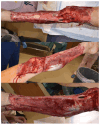Managing Necrotizing Soft Tissue Infections of the Lower Limb: Microsurgical Reconstruction and Hospital Resource Demands-A Case Series from a Tertiary Referral Center
- PMID: 40364028
- PMCID: PMC12072915
- DOI: 10.3390/jcm14092997
Managing Necrotizing Soft Tissue Infections of the Lower Limb: Microsurgical Reconstruction and Hospital Resource Demands-A Case Series from a Tertiary Referral Center
Abstract
Background: Necrotizing soft tissue infections (NSTIs) of the lower extremities represent a surgical emergency with high morbidity, complex reconstruction, and considerable healthcare demands. Free tissue transfer (FTT) is increasingly utilized for limb salvage in extensive soft tissue defects, yet its implications for hospital resource utilization remain unclear. This study aims to compare clinical outcomes and perioperative resource demands between FTT and local flap (LF) reconstruction in NSTI patients. Methods: A retrospective case series was conducted at a tertiary referral center between September 2022 and January 2025, including eight patients with NSTI of the lower extremity (FTT, n = 4; LF, n = 4). Demographic data, comorbidities, surgical timing, complication profiles, and resource utilization metrics-including operative duration, hospitalization length, and number of procedures-were analyzed. All FTT cases underwent preoperative CT angiography as part of institutional protocol. Results: Mean time to definitive reconstruction was longer in the FTT group (17.25 vs. 8 days, p = 0.15), reflecting staged infection control. FTT procedures demonstrated significantly longer operative times (331.75 vs. 170.25 minutes, p = 0.015), but there was no significant difference in total hospital stay (34.75 vs. 27.71 days, p = 0.65). No cases of flap loss or venous congestion were observed, and outcomes were optimized via delayed dangling protocols. Conclusions: FTT is a viable and effective reconstructive modality for lower extremity NSTIs. Despite increased surgical complexity, FTT did not significantly increase hospital resource utilization, supporting its role in limb preservation among appropriately selected patients.
Keywords: anterolateral thigh flap; dangling protocol; free tissue transfer; hospital length of stay; infection control; latissimus dorsi flap; limb salvage; local flaps; lower extremity reconstruction; microsurgical limb reconstruction; microsurgical reconstruction; multimodal analgesia; necrotizing fasciitis; necrotizing soft tissue infections; pain management; postoperative rehabilitation; regional anesthesia; retrospective case series; soft tissue defects; surgical debridement; surgical outcomes; surgical resource utilization; wound healing.
Conflict of interest statement
The authors declare no conflicts of interest.
Figures


Similar articles
-
Free tissue transfer for necrotizing fasciitis reconstruction: A case series.Burns. 2017 Nov;43(7):1561-1566. doi: 10.1016/j.burns.2017.04.007. Epub 2017 May 20. Burns. 2017. PMID: 28536044
-
Institutional Experience and Orthoplastic Collaboration Associated with Improved Flap-based Limb Salvage Outcomes.Clin Orthop Relat Res. 2021 Nov 1;479(11):2388-2396. doi: 10.1097/CORR.0000000000001925. Clin Orthop Relat Res. 2021. PMID: 34398852 Free PMC article.
-
Limb Salvage and Functional Outcomes following Free Tissue Transfer for the Treatment of Recalcitrant Diabetic Foot Ulcers.J Reconstr Microsurg. 2019 Feb;35(2):117-123. doi: 10.1055/s-0038-1667363. Epub 2018 Aug 12. J Reconstr Microsurg. 2019. PMID: 30099733
-
One-stage reconstruction of composite bone and soft-tissue defects in traumatic lower extremities.Plast Reconstr Surg. 2004 Nov;114(6):1457-66. doi: 10.1097/01.prs.0000138811.88807.65. Plast Reconstr Surg. 2004. PMID: 15509933 Review.
-
Flap coverage for necrotising soft tissue infections: A systematic review.Burns. 2021 Nov;47(7):1608-1620. doi: 10.1016/j.burns.2021.01.005. Epub 2021 Feb 3. Burns. 2021. PMID: 34172327
References
-
- Hodgins N., Damkat-Thomas L., Shamsian N., Yew P., Lewis H., Khan K. Analysis of the increasing prevalence of necrotising fasciitis referrals to a regional plastic surgery unit: A retrospective case series. J. Plast. Reconstr. Aesthetic Surg. 2015;68:304–311. doi: 10.1016/j.bjps.2014.11.003. - DOI - PubMed
LinkOut - more resources
Full Text Sources

